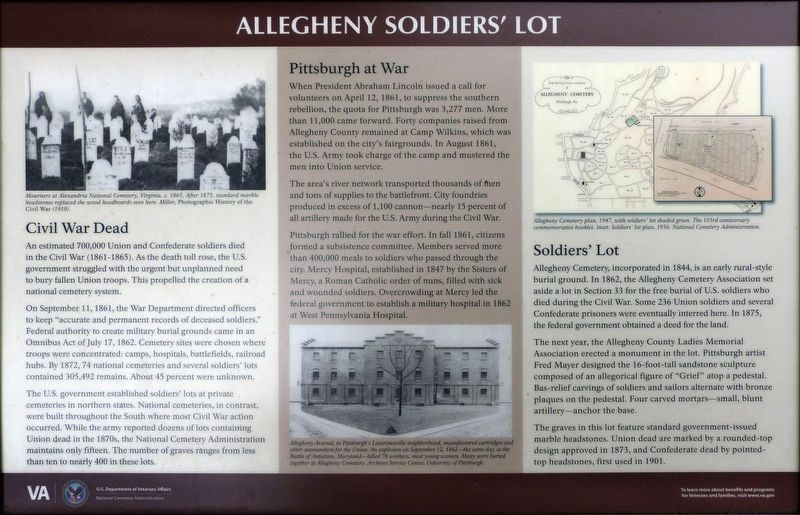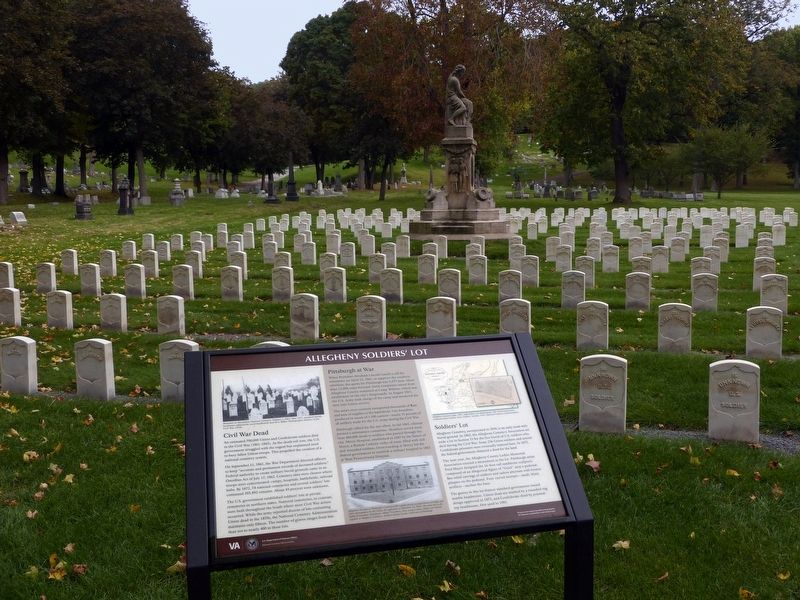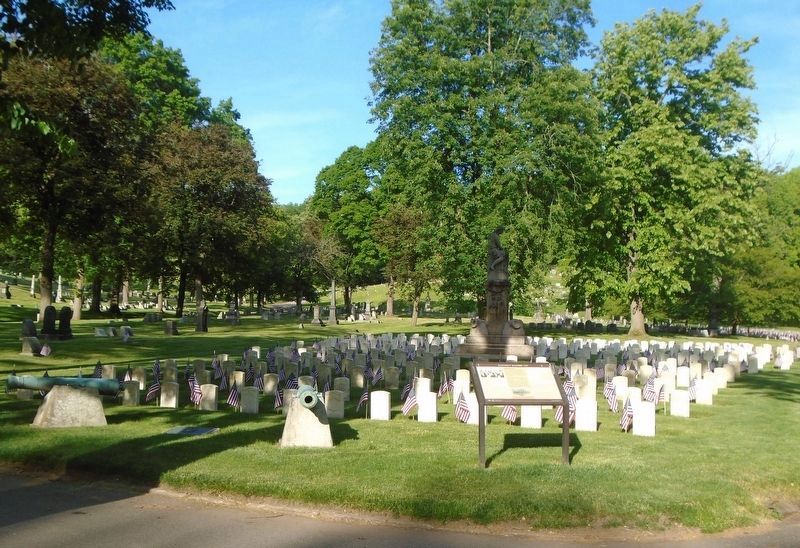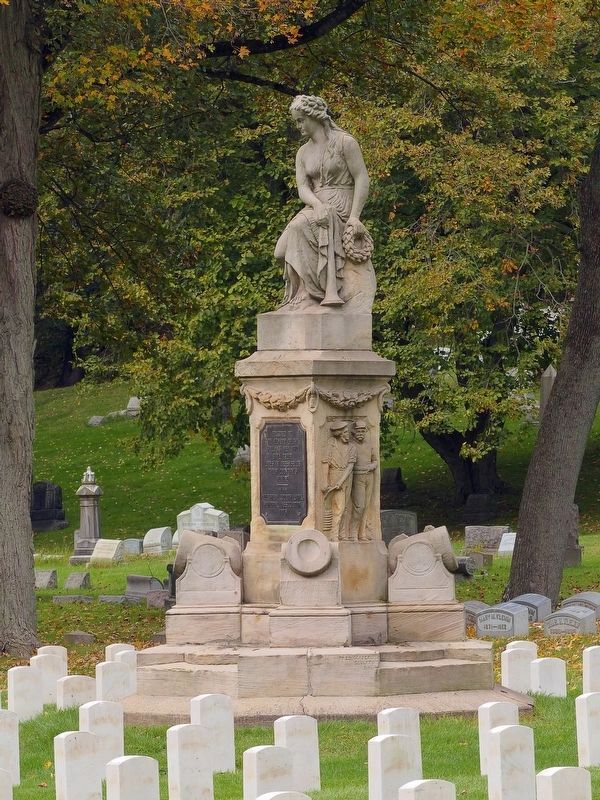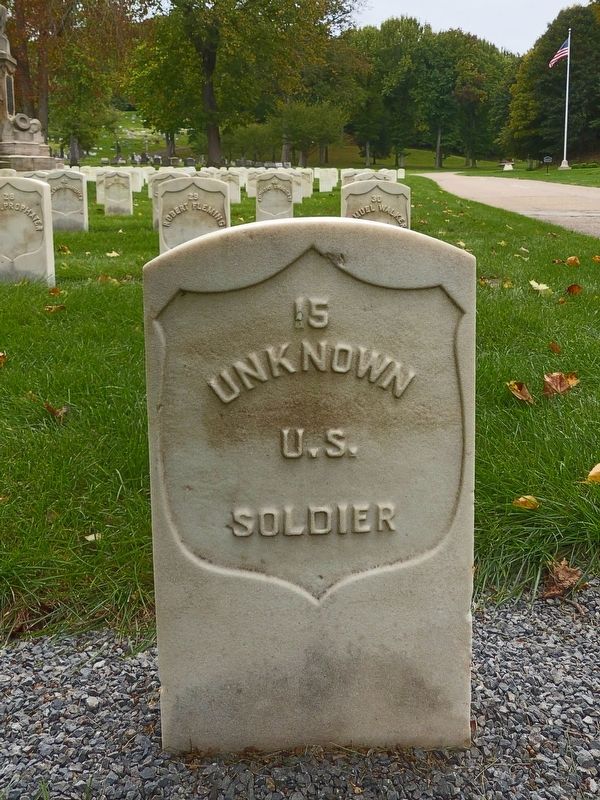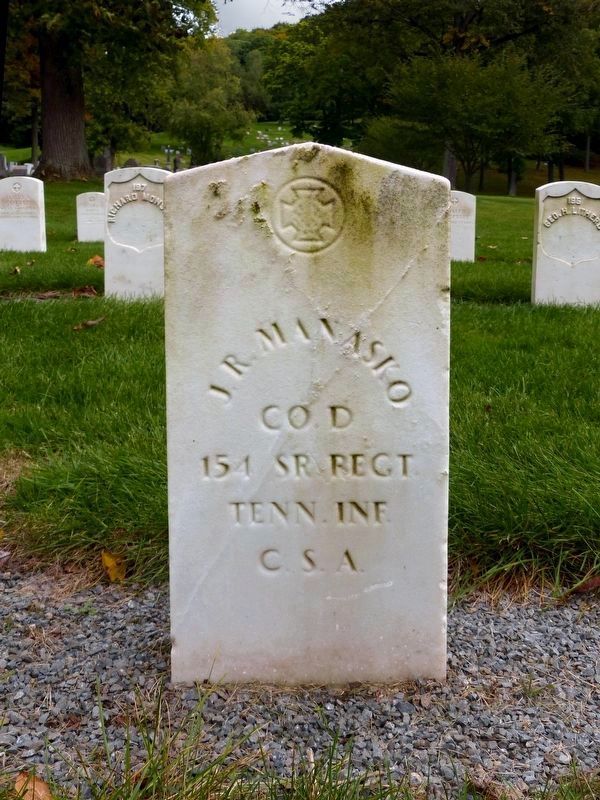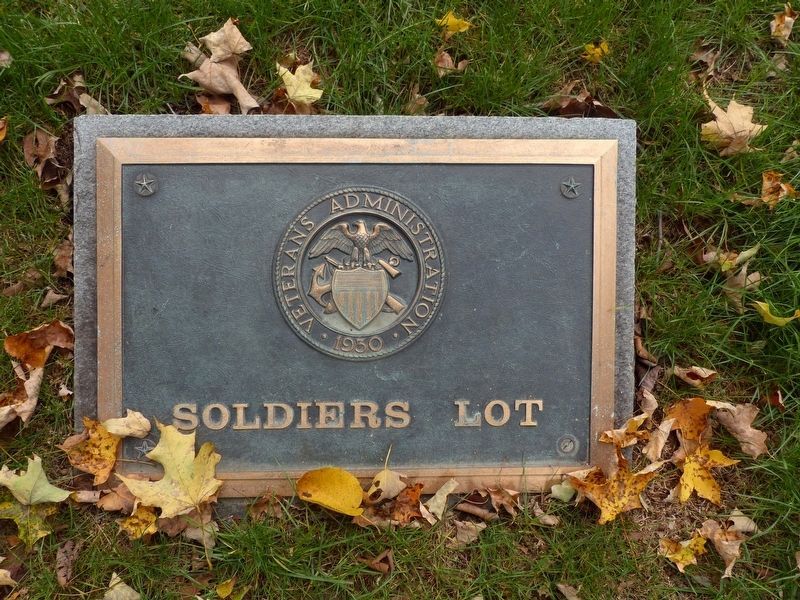Central Lawrenceville in Pittsburgh in Allegheny County, Pennsylvania — The American Northeast (Mid-Atlantic)
Allegheny Soldiers' Lot
An estimated 700,000 Union and Confederate soldiers died in the Civil War (1861-1865). As the death toll rose, the U.S. government struggled with the urgent but unplanned need to bury fallen Union troops. This propelled the creation of a national cemetery system.
On September 11, 1861, the War Department directed officers to keep "accurate and permanent records of deceased soldiers." Federal authority to create military burial grounds came in an Omnibus Act of July 17, 1862. Cemetery sites were chosen where troops were concentrated: camps, hospitals, battlefields, railroad hubs. By 1872, 74 national cemeteries and several soldiers' lots contained 305,492 remains. About 4S percent were unknown.
The U.S. government established soldiers' lots at private cemeteries in northern states. National cemeteries, in contrast, were built throughout the South where most Civil War action occurred. While the army reported dozens of lots containing Union dead in the 1870s, the National Cemetery Administration maintains only fifteen. The number ofgraves ranges from less than ten to nearly 400 in these lots.
Pittsburgh at War
When President Abraham Lincoln issued a call for volunteers on April 12, 1861, to suppress the southern rebellion, the quota for Pittsburgh was 3,277 men. More than 11,000 came forward. Forty companies raised from Allegheny County remained at Camp Wilkins, which was established on the city's fairgrounds. In August 1861, the U.S. Army took charge of the camp and mustered the men into Union service.
The area's river network transported thousands of then and tons of supplies to the battlefront. City foundries produced in excess of 1,100 cannon-nearly 15 percent of all artillery made for the U.S. Army during the Civil War.
Pittsburgh rallied for the war effort. In fall 1861, citizens formed a subsistence committee. Members served more than 400,000 meals to soldiers who passed through the city. Mercy Hospital, established in 1847 by the Sisters of Mercy, a Roman Catholic order of nuns, filled with sick and wounded soldiers. Overcrowding at Mercy led the federal government to establish a military hospital in 1862 at West Pennsylvania Hospital.
Soldiers' Lot
Allegheny Cemetery, incorporated in 1844, is an early rural-style burial ground. In 1862, the Allegheny Cemetery Association set aside a lot in Section 33 for the free burial of U.S. soldiers who died during the Civil War. Some 236 Union soldiers and several Confederate prisoners were eventually interred here. In 1875, the federal government obtained a deed for the land.
The next year, the Allegheny County Ladies Memorial Association erected a monument in the lot. Pittsburgh artist Fred Mayer designed the 16-foot-tall sandstone sculpture composed of an allegorical figure of "Grief" atop a pedestal. Bas-relief carvings of soldiers and sailors alternate with bronze plaques on the pedestal. Four carved mortars-small, blunt artillery-anchor the base.
The graves in this lot feature standard government-issued marble headstones. Union dead are marked by a rounded-top design approved in 1873, and Confederate dead by pointed top headstones, first used in 1901.
Erected by U.S. Department of Veterans Affairs.
Topics. This memorial is listed in these topic lists: Cemeteries & Burial Sites • War, US Civil.
Location. 40° 28.55′ N, 79° 57.038′ W. Marker is in Pittsburgh, Pennsylvania, in Allegheny County. It is in Central Lawrenceville. Memorial can be reached from Butler Street north of Umpire Way, on the right when traveling north. In the Allegheny Cemetery. Touch for map. Marker is at or near this postal address: 4734 Butler Street, Pittsburgh PA 15224, United States of America. Touch for directions.
Other nearby markers. At least 8 other markers are within walking distance of this marker. Civil War Memorial (a few steps from this marker); Veterans Memorial (within shouting distance of this marker); The Honorable Thomas Marshall Howe (approx. ¼ mile away); Daniel William Cooper (approx. 0.4 miles away); Allegheny Cemetery (approx. 0.4 miles away); Charles Parkin (approx. 0.4 miles away); Calbraith Perry Rodgers (approx. 0.4 miles away); Gen. James Scott Negley (approx. 0.4 miles away). Touch for a list and map of all markers in Pittsburgh.
Also see . . . Allegheny Cemetery. (Submitted on October 24, 2016.)
Credits. This page was last revised on June 5, 2023. It was originally submitted on October 23, 2016, by Allen C. Browne of Silver Spring, Maryland. This page has been viewed 518 times since then and 23 times this year. Photos: 1, 2. submitted on October 23, 2016, by Allen C. Browne of Silver Spring, Maryland. 3. submitted on June 5, 2023, by William Fischer, Jr. of Scranton, Pennsylvania. 4, 5, 6, 7. submitted on October 23, 2016, by Allen C. Browne of Silver Spring, Maryland. • Bernard Fisher was the editor who published this page.
